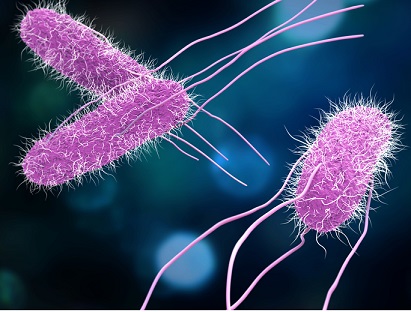Biological Contaminants
Biological contaminants may include bacterial and viral pathogens. Fungal contamination is discussed under mycotoxins, which are the chemical contaminants produced by these organisms. Under the Animal Food Contaminants Program, biological contaminants that are monitored include Salmonella, Listeria monocytogenes, and pathogenic Escherichia coli. These pathogens may present a hazard to animal health when animals consume contaminated food, and to human health by consumption of contaminated animal products, or by direct exposure to the contaminated animal food capable of causing disease in humans.
On this page:
Salmonella
Listeria monocytogenes (L. monocytogenes)
Pathogenic Escherichia coli (E. coli)
Guidance
Assignments/Reports
Additional Information
Salmonella
Salmonella are the bacteria responsible for salmonellosis in humans and animals. Salmonella can infect animals through consumption of Salmonella-contaminated animal food, and humans can be infected by handling such animal food or infected animals and their feces.
Animal food can become contaminated with Salmonella through the inclusion of Salmonella-contaminated raw materials (ingredient-related), Salmonella-contaminated manufacturing environment (facility-related), and when the manufacturing process is inadequate to kill the Salmonella (process-related). Meat and poultry ingredients, including rendered ingredients, have been sources of Salmonella contamination.
Listeria monocytogenes (L. monocytogenes)
L. monocytogenes is a bacterium responsible for listeriosis in humans and animals. L. monocytogenes can infect animals through consumption of L. monocytogenes contaminated animal food, and humans can be infected by handling such animal food or infected animals and their feces.
Animal food can become contaminated with L. monocytogenes through the inclusion of L. monocytogenes-contaminated raw materials (ingredient-related), L. monocytogenes-contaminated manufacturing environment (facility-related), and when the manufacturing process is inadequate to kill the L. monocytogenes (process-related). Raw meat and poultry, raw milk, oil seeds, fruits and vegetables have been sources of L. monocytogenes contamination.
Pathogenic Strains of Escherichia coli (Pathogenic E. coli)
Pathogenic E. coli are bacteria associated with foodborne illness in humans and animals. Pathogenic E. coli can infect animals through consumption of E. coli-contaminated animal food, and humans can be infected by handling such animal food or infected animals and their feces. Some raw pet food and jerky type treats have been sources of E. coli contamination.
Guidance
Assignments/Reports
Additional Information
- CDC-Salmonella
- Bacteriological Analytical Manual (BAM)
- FDA's Bad Bug Book
- Get the Facts about Salmonella
- Get the Facts about Listeria

